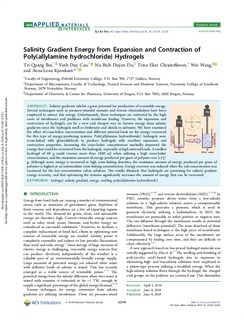| dc.contributor.author | Bui, Tri Quang | |
| dc.contributor.author | Cao, Vinh Duy | |
| dc.contributor.author | Do, Nu Bich Duyen | |
| dc.contributor.author | Christoffersen, Trine Eker | |
| dc.contributor.author | Wang, Wei | |
| dc.contributor.author | Kjøniksen, Anna-Lena | |
| dc.date.accessioned | 2018-09-27T08:33:52Z | |
| dc.date.available | 2018-09-27T08:33:52Z | |
| dc.date.created | 2018-07-09T09:37:45Z | |
| dc.date.issued | 2018 | |
| dc.identifier.citation | ACS Applied Materials and Interfaces. 2018, 10 (26), 22218-22225. | nb_NO |
| dc.identifier.issn | 1944-8244 | |
| dc.identifier.uri | http://hdl.handle.net/11250/2564875 | |
| dc.description | This is an open access article published under an ACS AuthorChoice License, which permits copying and redistribution of the article or any adaptations for non-commercial purposes. | nb_NO |
| dc.description.abstract | Salinity gradients exhibit a great potential for production of renewable energy. Several techniques such as pressure-retarded osmosis and reverse electrodialysis have been employed to extract this energy. Unfortunately, these techniques are restricted by the high costs of membranes and problems with membrane fouling. However, the expansion and contraction of hydrogels can be a new and cheaper way to harvest energy from salinity gradients since the hydrogels swell in freshwater and shrink in saltwater. We have examined the effect of cross-linker concentration and different external loads on the energy recovered for this type of energy-producing systems. Poly(allylamine hydrochloride) hydrogels were cross-linked with glutaraldehyde to produce hydrogels with excellent expansion and contraction properties. Increasing the cross-linker concentration markedly improved the energy that could be recovered from the hydrogels, especially at high external loads. A swollen hydrogel of 60 g could recover more than 1800 mJ when utilizing a high cross-linker concentration, and the maximum amount of energy produced per gram of polymer was 3.4 J/g. Although more energy is recovered at high cross-linking densities, the maximum amount of energy produced per gram of polymer is highest at an intermediate cross-linking concentration. Energy recovery was reduced when the salt concentration was increased for the low-concentration saline solution. The results illustrate that hydrogels are promising for salinity gradient energy recovery, and that optimizing the systems significantly increases the amount of energy that can be recovered. | nb_NO |
| dc.language.iso | eng | nb_NO |
| dc.rights | Navngivelse-Ikkekommersiell 4.0 Internasjonal | * |
| dc.rights.uri | http://creativecommons.org/licenses/by-nc/4.0/deed.no | * |
| dc.title | Salinity Gradient Energy from Expansion and Contraction of Poly (allylamine hydrochloride) Hydrogels | nb_NO |
| dc.title.alternative | Salinity Gradient Energy from Expansion and Contraction of Poly(allylamine hydrochloride) Hydrogels | nb_NO |
| dc.type | Journal article | nb_NO |
| dc.type | Peer reviewed | nb_NO |
| dc.description.version | publishedVersion | nb_NO |
| dc.rights.holder | 2018 ACS AuthorChoice | nb_NO |
| dc.source.pagenumber | 22218-22225 | nb_NO |
| dc.source.volume | 10 | nb_NO |
| dc.source.journal | ACS Applied Materials and Interfaces | nb_NO |
| dc.source.issue | 26 | nb_NO |
| dc.identifier.doi | 10.1021/acsami.8b05333 | |
| dc.identifier.cristin | 1596299 | |
| cristin.unitcode | 222,58,4,0 | |
| cristin.unitname | Institutt for mikrosystemer | |
| cristin.ispublished | true | |
| cristin.fulltext | original | |
| cristin.qualitycode | 1 | |

